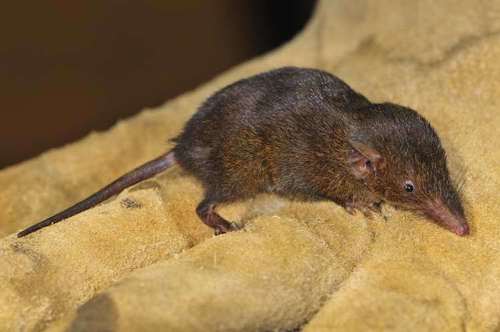If you cannot find the answer you are looking for, please contact us.
Dryad shrew tenrec

First described in 1992 by Jenkins, the Dryad Shrew Tenrec is unique among its relatives for its flattened quills along the dorsal hairs, a rare feature in the genus that gives it a distinctive appearance.
Taxonomy
| Kingdom: | Animalia |
| Phylum: | Chordata |
| Class: | Mammalia |
| Order: | Afrosoricida |
| Suborder: | Tenrecomorpha |
| Family: | Tenrecidae |
| Genus: | Microgale |
| Species: | Microgale dryas |
Natural range & habitat
The Dryad Shrew Tenrec is endemic to northeastern Madagascar, known only from a few scattered populations in lowland and mid‑elevation rainforest between approximately 600 and 750 m above sea level, especially around Ambatovaky Special Reserve. Because it has only been recorded in a handful of localities within primary forest, its distribution appears extremely limited, and habitat specialists suspect it may occur in other nearby protected forests. Its rarity makes it difficult to assess habitat flexibility.
Physical traits
A small, slender insectivore, the Dryad Shrew Tenrec measures about 170 to 180 mm in total length (including tail) but weighs only around 40 g, a relatively heavier build among shrew‑tenrecs. Its body is spindle-shaped with short limbs, soft dense fur, and a comparatively short tail. The most notable trait is the presence of flattened shafts on its dorsal guard hairs, creating a somewhat bristled appearance not seen in most other Microgale.
Behavior & lifestyle
Almost nothing is known about Dryad Shrew Tenrec behavior because the species is rarely encountered in the wild. It is presumed to be terrestrial and secretive, sheltering in dense leaf litter or under logs. Based on the habits of related Microgale species, it likely forages at irregular times during day or night, remains solitary, and may build simple nests for its young. Quantitative data on home range, activity rhythms, or thermoregulation are currently lacking.
Communication
No direct observations have been made of vocal or chemical communication in Dryad Shrew Tenrecs. Like other shrew tenrecs, it probably uses scent marking and tactile cues, especially during mother–offspring care. Occasional high‑pitched squealing observed in related species may occur here, but confirmation is absent.
Diet in the wild
While no dietary studies exist specifically for the Dryad Shrew Tenrec, its structure and comparisons with congeners suggest it feeds on small invertebrates, earthworms, insects and other ground-dwelling prey. This assumption aligns with observations of captive individuals in the genus favoring grasshoppers and worms. Precise diet composition in the wild remains unstudied.
Reproduction & life cycle
Breeding presumably coincides with Madagascar’s rainy season beginning in September, and gestation typically lasts two to four months in related species, yielding one to four young per litter. Young are likely born altricial and weaned in about a month. However, any data specific to Dryad Shrew Tenrecs, including litter frequency, timing, or parental behavior, appear entirely absent from scientific literature.
Threats & conservation status
The International Union for Conservation of Nature (IUCN) lists this species as Vulnerable due to its very limited known range and the ongoing loss of lowland rainforest in northeastern Madagascar. It has only ever been documented in a small number of sites, and large-scale deforestation for agriculture, logging and development seriously threaten its habitat. Several reserves, including Ambatovaky and Anjanaharibe‑Sud, provide some protection, but much remains unknown about its true distribution and population size.
This species in captivity
Cowan’s Shrew Tenrec is not known to have ever been kept in captivity. There are no records of individuals maintained in zoos or private collections, and no husbandry or breeding studies exist. As a result, its tolerance to captivity or potential for ex situ conservation remains unexplored.
